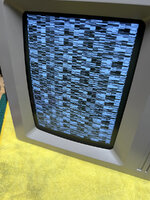3lectr1cPPC
Well-known member
That looks pretty dang good! Very clever.
Go to a plastic model shop and get a product called micro-set and micro-sol. This will help the decal set better and the sol will help it conform to non-flat surfaces. The are other similar products and the shop owner will be well aware of them. Almost all modellers have this in their arsenal of tools.
Go to a plastic model shop and get a product called micro-set and micro-sol. This will help the decal set better and the sol will help it conform to non-flat surfaces. The are other similar products and the shop owner will be well aware of them. Almost all modellers have this in their arsenal of tools.
Off topic, "I can't locate a battery in the right slot" seems like an oddly anthropomorphizing error message. Are there are other examples from the classic Mac OS where the computer refers to itself in the first person?Still doesn’t see it though…
My iMac DV SE proudly states underneath “I was assembled in the USA”Off topic, "I can't locate a battery in the right slot" seems like an oddly anthropomorphizing error message. Are there are other examples from the classic Mac OS where the computer refers to itself in the first person?

Hmm... Applied Engineering Mac SE II Accelerator. 68030 on board as well as memory.

A quick hack to make this is to just get an ATX PSU extension cable, and cut down the male end to fit the Mac logic board plug (the rest of the connector hanging off the side would likely collide with the PDS card in this case). As long as you plug in the analog board cable the right way on the female side, it's just fine like that.But I think I need to build an extension for the analog board to motherboard cable as the stock cable isn't long enough to place the motherboard on my bench outside of the Macintosh SE.
A quick hack to make this is to just get an ATX PSU extension cable, and cut down the male end to fit the Mac logic board plug (the rest of the connector hanging off the side would likely collide with the PDS card in this case). As long as you plug in the analog board cable the right way on the female side, it's just fine like that.
Still never seen an M0131 in real life!
My SE/30
Spent today recapping the analog board and PSU on a second SE/30 and also the SE that I procured recently. Both of those recap jobs were also successes. The SE is working well although I still need to debug the accelerator card. The SE/30 however was known to have issues and I'm still working through those.
Problem #1: random crashes on boot - turned out to be a bad RAM stick. Resolved.
Problem #2: stuck on gray screen on power up with no chime - reseated the ROM. Resolved.
Problem #3: chime on start up is staticky, low volume, and cuts off - haven't debugged yet but I know it's not the speaker as it tested fine using a few other boards.
Problem #4: hang on startup - booting using System 7.5.5, after the Welcome to Macintosh screen it shows the Mac face screen, and then before it gets to showing any CDEV icons on the startup, system hangs. It just gets stuck. Haven't debugged yet.
I then decided to not use SCSI but boot with a floppy. That worked! It booted completely and the system was usable. The system version on the SCSI device and on the floppy were different. So it's either the SCSI subsystem or it could be differences in the OS (triggering an issue in the hardware of course).
Have you tried cleaning the headphone jack?e volume fades and then sound cuts out.
Have you tried cleaning the headphone jack?
Also, how do the solder joints look at the sound ICs? It's possible one of them is faulty or there's an intermittent connection?
c
Right, but there's a switch inside the jack that disconnects the speaker when headphones are plugged in. I don't think it's impossible for that switch to get intermittent and cause symptoms similar to what you're describing.My issue is with the sound that’s supposed to come out of the speaker.
Right, but there's a switch inside the jack that disconnects the speaker when headphones are plugged in. I don't think it's impossible for that switch to get intermittent and cause symptoms similar to what you're describing.
What I'm going on is that when that jack is removed, there will be no sound from the speaker.
